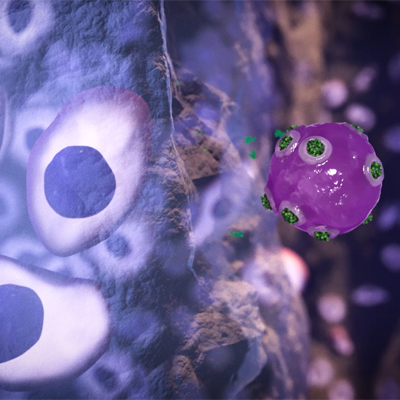Stem cells: a new frontier
For some diseases where traditional treatments fail, stem cells may become a game changer, both for human and animal health. The veterinary field in particular is leaping towards new discoveries and medicines. Boehringer Ingelheim’s newly acquired biotechnology company, Global Stem cell Technology (GST), is at the very frontier of this development. So what exactly are stem cells, and what makes them so powerful?

Mesenchymal stem cells have incredible capabilities: they can mobilize the body’s innate power to heal itself. “When you inject stem cells into a diseased organism, they will move to the hot spots and create a new balance,” shares Glenn Pauwelyn, formerly Senior Scientist at GST and now part of Animal Health Global Innovation at Boehringer Ingelheim. The stem cells attach themselves to injured tissue, starting a regenerative process from within by their immunomodulatory effect on the innate and adaptive immune system. When the immune system is acting out, mesenchymal stem cells can get it back on track. “Mesenchymal stem cells have the potential to tackle vastly different inflammatory and immune-mediated diseases – orthopedic issues, chronic kidney disease, cancer, allergies, skin conditions – and many more we don’t even know of yet!” Glenn adds.
This broad range of possibilities is what makes opportunities like this so attractive to the company both from a scientific and a strategic point of view. “This is exactly in line with our strategy,” highlights Eric Haaksma, Head of Animal Health Global Innovation Boehringer Ingelheim. “We look at the disease process – in this case we look at how inflammatory and immune-mediated diseases occur in general. We no longer focus only on a single species, i.e., we don’t just look at how we can treat lameness in horses. Further research into these cells means opening new doors and exploring innovative approaches to address unmet medical needs.”
Meet the powerhouse
The bodies of all humans and animals are made up of trillions of cells, the vast majority of which are specialized. They serve a purpose as blood cells, nerve cells, liver cells, and so on. Specialization of cells allows for the growth and formation of complex physiological structures – but it also means that these cells are pretty much fixed in their development. Mesenchymal stem cells, however, are a clean slate. These cells have not differentiated yet and can turn into different cell types – or be persuaded to transform into a desired cell type thanks to modern technology. Furthermore, they possess unique abilities to modulate the immune system. And Boehringer Ingelheim, with GST now becoming an integral part of the organization, turns stem cells from horses into powerful medical treatments.
Horses’ stem cells improve health
Equine mesenchymal stem cells possess unique cultivation properties and are easily obtained from a healthy donor horse. All you need to do is draw a bit of the horse’s blood – as you would for a blood test. To achieve the high concentration of stem cells needed for treatment, Glenn and his colleagues multiply them in the lab, then develop them for use in a product that treats lameness in horses.
“By administering stem cells, you can preserve quality of life and fight underlying causes,” explains Glenn. Veterinarians inject this product directly into a lame horse’s joints, so that it has its effect exactly where needed. To make the healing process most effective, Glenn and his colleagues utilize chondrogenic-induced stem cells. These kinds of stem cells have been stimulated in the lab to develop into a pre-differentiated status. “This works well for horses, as they have large joints, and, in this case, allows us to achieve the best results. However, we’re already working on new stem cell solutions for cats and dogs,” Glenn notes. “And for pets, it may make more sense to treat systemically.”
A systemic treatment would entail injecting undifferentiated mesenchymal stem cells into the blood stream. The stem cells then move through the organism and start to take effect wherever the organism is unbalanced. “This is what we’re currently looking into – and hopefully this will lead to new avenues for pet medications in the future!”
On the cusp of revolution
“Every day I’m learning more about what stem cells can do, I can see the clinical improvement,” concludes Glenn. “That’s what’s so exciting about stem cells. It’s a field just at the onset of development. And where other treatments fail, we have the chance to heal.”




